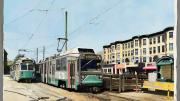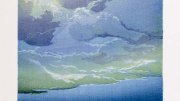From skyscrapers to stormy seas, “New England on Paper,” at the Boston Athenaeum, offers 56 contemporary works. They reflect “responses to the region’s built, natural, and cultural environment,” says Catharina Slautterback, curator of the library’s 100,000 prints and photographs. Using the Japanese hanga technique, New Hampshire wood-block artist Matt Brown ’81 created Moon Over Mt. Desert Island (2010). Three impressions of the image hang as a triptych because Slautterback loves how, in “relating to one another, they show the passage of time.” All of the works were bought with help from a print fund for regional artists that honors Francis Hovey Howe ’52, Ed.M. ’73. (The art collector and Athenaeum member was also an early-childhood educator instrumental in forming Harvard’s first daycare centers.) Slautterback clearly seeks a diversity of styles. Eric Goldberg’s poignant etching Deep in the Valley (2006), pairs expansive Connecticut River valley farmlands with an intimate view of a woman reading a letter. Realist painter Kate Sullivan used pastel and watercolor in End of the Line, Cleveland Circle (2012). “It all results in a loud cheerfulness,” the artist wrote in the wall label, “and a distinctive sense of place.”
Boston Athenaeum print exhibit
Boston Athenaeum print exhibit
A Boston Athenaeum print exhibit reveals “a distinctive sense of place.”

End of the Line, Cleveland Circle (2012), by Kate Sullivan
Courtesy of the Boston Athenaeum

Moon Over Mt. Desert Island (2010), by Matt Brown ’81
Courtesy of the Boston Athenaeum
You might also like
Mount Vernon, Historic Preservation, and American Politics
Anne Neal Petri promotes George Washington and historic literacy.
England’s First Sports Megastar
A collection of illustrations capture a boxer’s triumphant moment.
Creepy Crawlies and Sticky Murder Weapons at Harvard
In the shadows of Singapore’s forests, an ancient predator lies in wait—the velvet worm.
Most popular
Explore More From Current Issue

Mount Vernon, Historic Preservation, and American Politics
Anne Neal Petri promotes George Washington and historic literacy.

The Trouble with Sidechat
No one feels responsible for what happens on Harvard’s anonymous social media app.

Open Book: A New Nuclear Age
Harvard historian Serhii Plokhy’s latest book looks at the rising danger of a new arms race.




